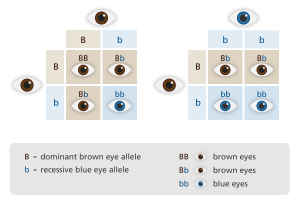Dominant and Recessive Genes
Learning Objectives
Know what it means for a gene to be dominant
Understand why dominance sometimes doesn’t matter for sex-linked genes
Have you ever wondered why some people have blue or brown eyes? The coloring of the blue and brown eyes is an example of different versions of a gene. Different versions of a gene are called alleles. Alleles can be considered dominant or recessive, with dominant being the trait that is observed or shown and recessive being the trait is not seen.
Dominant alleles are seen as an uppercase of a letter; for example, B. Recessive alleles are seen as a lower case of a letter; b. In order for a person to show the dominant trait, one of the person’s parents must have the dominant trait (which is an uppercase letter). Remember that human cells carry 2 copies of each chromosome, one from the biological mother’s genes and one from the biological father’s genes. With that being said, there are 2 sets of alleles that can be dominant or recessive. If a person carries a heterozygous set of alleles (both uppercase and lower case letter of the gene) then the person will show the dominant trait (being that there is an uppercase letter present). For example, the brown eye allele is dominant, B. You would need at least one copy of the brown eye allele (B) to have brown eyes. When you have two copies of the alleles that are both dominant, this is called codominance. For example, if the dominant trait is red for flowers and another dominant trait is white, then the flower will have both red and white as the dominant traits are expressed equally. If a person carries two copies of the brown eye allele, since they are codominant, the person would have brown eyes. Recessive alleles are the genes that do not show the trait. If a person has one copy of the brown eye allele (dominant) and one copy of the blue eye allele (recessive) then that person is considered to be a carrier of the blue eye allele, since they would have brown eyes but still have the blue eye trait that is not shown. Recessive alleles only show the traits if the person has 2 copies of the same alleles. This is considered being homozygous, having the same 2 copies of alleles. If a person has 2 copies of the blue eye allele (both recessive) then the person would have blue eyes.

Image credit: Genome Research Limited
Sex-linked genes are genes that are inhererited through the X chromosome. Remember that a biological female carries 2 sets of X chromosomes (XX) and a biological male carries one set of the X and one set of Y chromosomes (XY). If the offspring is a boy, the X chromosome comes from the mother and the Y comes from the father. If the offspring is a girl, one of the X chromosomes comes from the mother and the other X chromosome comes from the father. In some genetic diseases that are caused by sex-linked genes, for example haemophila, a color blindness trait, the allele for the disease is recessive. You can recall that recessive traits are only shown if they are homozygous (both copies of the alleles are recessive). For a female to have the disease, both of her X chromosomes must carry the recessive diseased copies of alleles. For a male to have a sex-linked gene, only one copy of the recessive sex-linked gene is needed for the male to have the disease. Dominance does not matter in sex-linked genes for XY males. If the mother is a carrier (unaffected but still have the affected trait), her offspring could be affected. Males are more likely to inherit a sex-linked gene as only one chromosome of a diseased trait is needed, whether the disease trait is dominant or recessive. You can see that sex-linked genes are by chance. Even though the father is affected with a dominant trait, only half of their offspring is affected, especially from the girls because they have to inherit a chromosome from the father. The male offspring was unaffected because they had already received a Y chromosome from the father so they got the non affected X chromosome form the mother. In this photo, the mother is affected with a dominant trait but only half of their offspring was able to be affected. The offsprings had a 50% chance of getting the affected trait. With an unaffected mother whose carrier, meaning the disease trait is recessive, only one of the offspring was affected and one is unaffected but a carrier. This is an example of how dominance genes does not matter as it depends on which X chromosome you can get and whether or not the set chromosomes you inherited contain the diseased trait being dominant or recessive. With males especially, they would only get a 50/50 chance of inheriting a non diseased trait, as they can only get the X chromosome from the mother. With females, they have a lower chance of getting a diseased trait as it depends on what chromosome she inherited from the mother whether its dominant or recessive and what X chromosome she inherited from her father.

Title: What are dominant and recessive genes? Provided by: Yourgenome
URL: https://www.yourgenome.org/facts/what-are-dominant-and-recessive-alleles
License: Creative Commons Attribution 4.0 CC-BYCC LICENSED CONTENT, NEWLY CREATED
Title: Sex-Linked Genes Authored by: Rachel Lam Provided by: University of Minnesota License: CC BY 4.0
a specific variant of a gene
inhereted alleles do not match
when neither allele can dominate the expression of the other
having the allele for a trait that is not expressed
both inherited alleles are identical
A disease which prevents your blood from clotting

